-
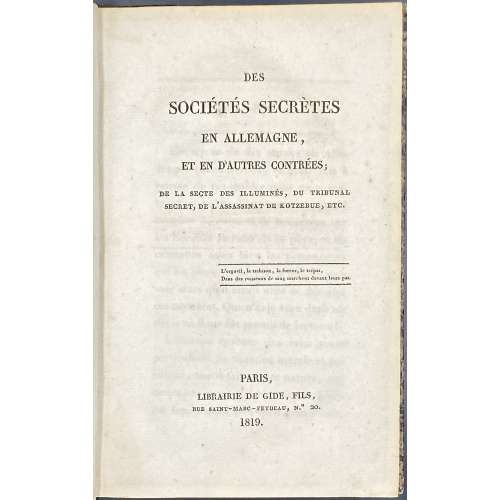 Hardcover volume, 20.4 x 13.1 cm, quarter contemporary calf over modern brown marbled board, printed on laid paper, pp.: [i-v] vi-xii, [13] 14-259 [260] blank; collated 8vo: 1-168 172; total 130 leaves. Title-page: DES | SOCIÉTÉS SECRÈTES | EN ALLEMAGNE, | ET EN D'AUTRES CONTREES; | DE LA SECTE DES ILLUMINÉS DU TRIBUNAL | SECRET, DE L'ASSASSINAT DE KOTZEBUE, ETC. | {two lines in rules} | PARIS, | LIBRAIRIE DE GIDE, FILS, | RUE SAINT–MARC–FEYDEAU, No. 20. | 1819. || Contributors: Vincent Lombard de Langres (French, 1765 – 1830) – author. Théophile-Étienne Gide (French, 1767 – 1837) – publisher. Seller's description: [LOMBARD DE LANGRES (Vincent)]. Des Sociétés secrètes en Allemagne, et en d'autres contrées. Paris, Gide fils, 1819 ; in 8°, demi basane fauve, dos lisse orné. Reliure de l'époque. Edition originale rare. L'auteur, révolutionnaire, fut ami de Danton et de Barras. Dans son ouvrage anti maçonnique, il dévoile les doctrines des sociétés secrètes, leurs principes, leur influence dans la société. Caillet 6770.
Hardcover volume, 20.4 x 13.1 cm, quarter contemporary calf over modern brown marbled board, printed on laid paper, pp.: [i-v] vi-xii, [13] 14-259 [260] blank; collated 8vo: 1-168 172; total 130 leaves. Title-page: DES | SOCIÉTÉS SECRÈTES | EN ALLEMAGNE, | ET EN D'AUTRES CONTREES; | DE LA SECTE DES ILLUMINÉS DU TRIBUNAL | SECRET, DE L'ASSASSINAT DE KOTZEBUE, ETC. | {two lines in rules} | PARIS, | LIBRAIRIE DE GIDE, FILS, | RUE SAINT–MARC–FEYDEAU, No. 20. | 1819. || Contributors: Vincent Lombard de Langres (French, 1765 – 1830) – author. Théophile-Étienne Gide (French, 1767 – 1837) – publisher. Seller's description: [LOMBARD DE LANGRES (Vincent)]. Des Sociétés secrètes en Allemagne, et en d'autres contrées. Paris, Gide fils, 1819 ; in 8°, demi basane fauve, dos lisse orné. Reliure de l'époque. Edition originale rare. L'auteur, révolutionnaire, fut ami de Danton et de Barras. Dans son ouvrage anti maçonnique, il dévoile les doctrines des sociétés secrètes, leurs principes, leur influence dans la société. Caillet 6770. -
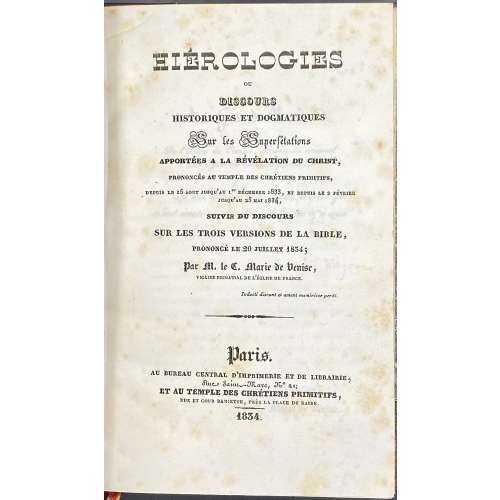 Hardcover volume, 20.7 x 13.5 cm, modern half morocco over marbled boards, gilt lettering and ornament to spine, pp.: [i-vii] viii-xvi [17] 18-255 [256], collated 8vo: 1-168, 128 leaves. Title-page: HIÉROLOGIES | OU | DISCOURS | HISTORIQUES ET DOGMATIQUES | Sur les Superfétations | APPORTÉES A LA RÉVÉLATION DU CHRIST, | PRONONCÉS AU TEMPLE DES CHRÉTIENS PRIMITIFS, | DEPUIS LE 15 AOUT JUSQU’AU 1er DÉCEMBRE 1833, ET DEPUIS LE 2 FÉVRIER | JUSQU’AU 25 MAI 1834, | SUIVIS DU DISCOURS | SUR LES TROIS VERSIONS DE LA BIBLE, | PRONONCÉ LE 20 JUILLET 1834 ; | Par M. le C. Marie de Venise, | VICAIRE PRIMATIAL DE L’EGLISE DE France. | {1 line citation} | — | Paris. | AU BUREAU CENTRAL D’IMPRIMERIE ET DE LIBRAIRE, | Rue Saint-Marc, No 21; | ET AU TEMPLE DES CHRÉTIENS PRIMITIFS, | RUE ET COUR DAMIETTE, PRÈS LA PLACE DU KAIRE. | — | 1834 || Contributors : Félix Ragon (French, 1795 – 1872) – author. Seller's description: [RAGON (Félix) : Hiérologies ou Discours historiques et dogmatiques sur les Superfétations apportées à la révélation du Christ suivis du Discours sur les trois versions de la Bible. Paris, au Bureau central et au Temple des Chrétiens Primitifs, 1834 ; in 8°, demi-basane brune à coins. Reliure pastiche moderne. Edition originale extrêmement rare, dont le tirage est estimé à 50 ex.
Hardcover volume, 20.7 x 13.5 cm, modern half morocco over marbled boards, gilt lettering and ornament to spine, pp.: [i-vii] viii-xvi [17] 18-255 [256], collated 8vo: 1-168, 128 leaves. Title-page: HIÉROLOGIES | OU | DISCOURS | HISTORIQUES ET DOGMATIQUES | Sur les Superfétations | APPORTÉES A LA RÉVÉLATION DU CHRIST, | PRONONCÉS AU TEMPLE DES CHRÉTIENS PRIMITIFS, | DEPUIS LE 15 AOUT JUSQU’AU 1er DÉCEMBRE 1833, ET DEPUIS LE 2 FÉVRIER | JUSQU’AU 25 MAI 1834, | SUIVIS DU DISCOURS | SUR LES TROIS VERSIONS DE LA BIBLE, | PRONONCÉ LE 20 JUILLET 1834 ; | Par M. le C. Marie de Venise, | VICAIRE PRIMATIAL DE L’EGLISE DE France. | {1 line citation} | — | Paris. | AU BUREAU CENTRAL D’IMPRIMERIE ET DE LIBRAIRE, | Rue Saint-Marc, No 21; | ET AU TEMPLE DES CHRÉTIENS PRIMITIFS, | RUE ET COUR DAMIETTE, PRÈS LA PLACE DU KAIRE. | — | 1834 || Contributors : Félix Ragon (French, 1795 – 1872) – author. Seller's description: [RAGON (Félix) : Hiérologies ou Discours historiques et dogmatiques sur les Superfétations apportées à la révélation du Christ suivis du Discours sur les trois versions de la Bible. Paris, au Bureau central et au Temple des Chrétiens Primitifs, 1834 ; in 8°, demi-basane brune à coins. Reliure pastiche moderne. Edition originale extrêmement rare, dont le tirage est estimé à 50 ex. -
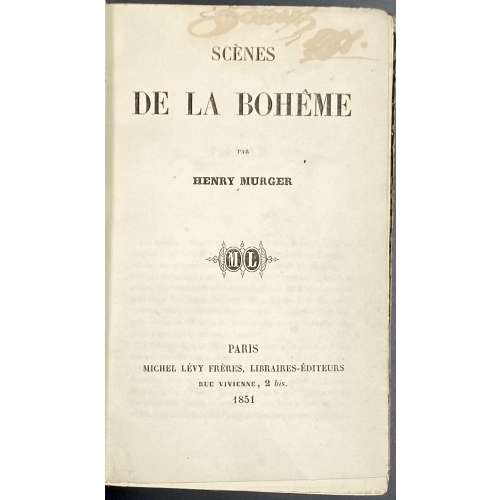 Hardcover volume, 18.2 x 11.8 cm, bound in quarter black polished calf with gilt lettering “cartonnage romantique” design to spine, marbled boards, matching marbled endpapers, blue margins. Title-page: SCÈNES | DE LA BOHÊME | PAR | HENRY MURGER | {publisher’s device ML} | PARIS | MICHEL LÉVY FRÈRES, LIBRAIRES-ÉDITEURS | RUE VIVIENNE, 2 bis. | 1851 || Half-title: ŒUVRES | D’HENRY MURGER || Advertisement: Chez le même Éditeurs. | BIBLIOTHEQUE CONTEMPORAINE | (page of text) || Collation: π2 (h.t/advert., t.p. / blank), 1-33 (17)12, χ6; total 212 leaves without ffls (3 front, 2 back). Pagination: [2] – h.t. / blank, [2] – t.p. / blank, [i] ii-xiii [xiv blank], [1] 2-406; total 424 pages. Scènes de la bohême, in later editions Scènes de la vie de bohème. Translations: Into English: LIB-2719.2021. Henri Murger. The Bohemians of the Latin Quarter. (Scènes de la vie de Bohême) / Translated from the French. — London: Vizetelly & Co., 1883. Into German: LIB-2686.2021. Henri Murger. Die Bohème : Szenen aus dem Pariser Künstlerleben. — Leipzig: Insel-Verlag, 1906. Into Russian: LIB-3182.2023. А. Мюрже. Сцены из жизни богемы / Пер. с франц. и прим. Е. А. Гунста; вст. ст. С. И. Великовского; художник Н. А. Кравченко. — М.: Художественная литература, 1963. Contributors: Murger, Henri [Henry] (French, 1822 – 1861) – author.
Hardcover volume, 18.2 x 11.8 cm, bound in quarter black polished calf with gilt lettering “cartonnage romantique” design to spine, marbled boards, matching marbled endpapers, blue margins. Title-page: SCÈNES | DE LA BOHÊME | PAR | HENRY MURGER | {publisher’s device ML} | PARIS | MICHEL LÉVY FRÈRES, LIBRAIRES-ÉDITEURS | RUE VIVIENNE, 2 bis. | 1851 || Half-title: ŒUVRES | D’HENRY MURGER || Advertisement: Chez le même Éditeurs. | BIBLIOTHEQUE CONTEMPORAINE | (page of text) || Collation: π2 (h.t/advert., t.p. / blank), 1-33 (17)12, χ6; total 212 leaves without ffls (3 front, 2 back). Pagination: [2] – h.t. / blank, [2] – t.p. / blank, [i] ii-xiii [xiv blank], [1] 2-406; total 424 pages. Scènes de la bohême, in later editions Scènes de la vie de bohème. Translations: Into English: LIB-2719.2021. Henri Murger. The Bohemians of the Latin Quarter. (Scènes de la vie de Bohême) / Translated from the French. — London: Vizetelly & Co., 1883. Into German: LIB-2686.2021. Henri Murger. Die Bohème : Szenen aus dem Pariser Künstlerleben. — Leipzig: Insel-Verlag, 1906. Into Russian: LIB-3182.2023. А. Мюрже. Сцены из жизни богемы / Пер. с франц. и прим. Е. А. Гунста; вст. ст. С. И. Великовского; художник Н. А. Кравченко. — М.: Художественная литература, 1963. Contributors: Murger, Henri [Henry] (French, 1822 – 1861) – author. -
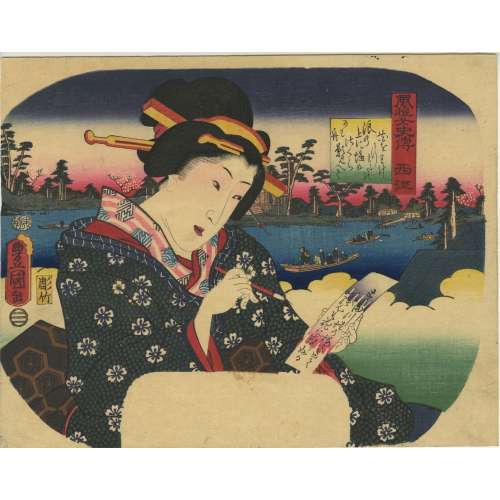 Artist: Utagawa Kunisada [歌川 国貞], a.k.a. Utagawa Toyokuni III [三代 歌川 豊国] (Japanese, 1786 – 1865). Signed: Toyokuni ga [豊国 画] in a red toshidama cartouche Block carver: Yokokawa Takejirō [横川竹二郎] (Japanese, fl. 1845 – 1863), seal: 彫竹 – hori Take. Publisher: Ibaya Senzaburō [伊場屋仙三郎] (Japanese, fl. c. 1845 – 1847). Media: Untrimmed fan print (uchiwa-e), 238 x 304 mm. Title: Saiko (West River) [西江]; 西江 means the Xi River in China. Series: Chronicles of Elegant Women [風雅女史傳] (Fūga joshiden). Combined date seal and kiwame censor seal: Ansei 6 (1859). Other prints from the same series in this collection: SVJP-0216.2016 — Princess Sotoori:
Artist: Utagawa Kunisada [歌川 国貞], a.k.a. Utagawa Toyokuni III [三代 歌川 豊国] (Japanese, 1786 – 1865). Signed: Toyokuni ga [豊国 画] in a red toshidama cartouche Block carver: Yokokawa Takejirō [横川竹二郎] (Japanese, fl. 1845 – 1863), seal: 彫竹 – hori Take. Publisher: Ibaya Senzaburō [伊場屋仙三郎] (Japanese, fl. c. 1845 – 1847). Media: Untrimmed fan print (uchiwa-e), 238 x 304 mm. Title: Saiko (West River) [西江]; 西江 means the Xi River in China. Series: Chronicles of Elegant Women [風雅女史傳] (Fūga joshiden). Combined date seal and kiwame censor seal: Ansei 6 (1859). Other prints from the same series in this collection: SVJP-0216.2016 — Princess Sotoori: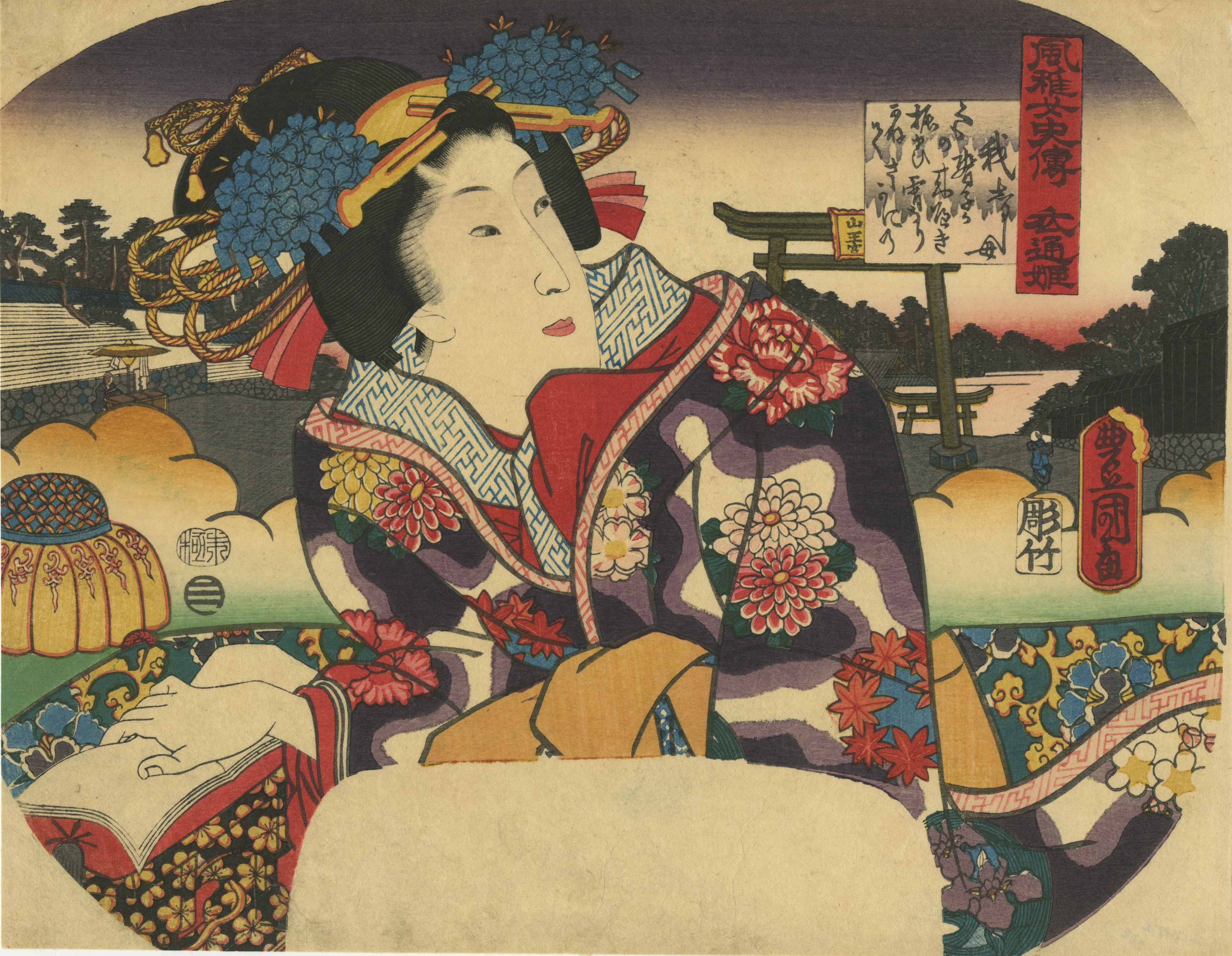
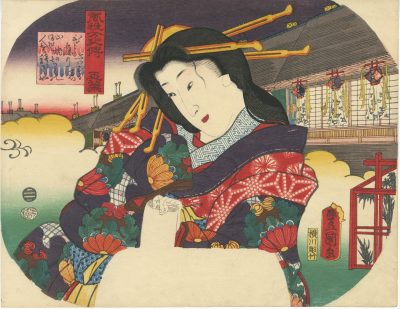
-
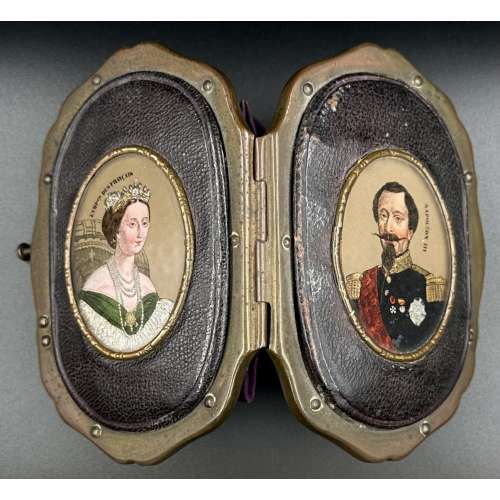 Coin purse, or porte-monnaie, made of patinated copper alloy, full-grain brown leather outside and purple inside, with a clutch and a hinge, and an oval miniature bust portrait on each side, painted in colour with gold and silver, by an anonymous artist after Franz Xaver Winterhalter, inscribed NAPOLÉON III and L'IMPCE DES FRANÇAIS, respectively, under glass. Dimensions: 97 x 67 x 18 mm. Contributors: Napoleon III [Charles Louis Napoléon Bonaparte] (French, 1808 – 1873) – character/sitter. Eugénie de Montijo [María Eugenia Ignacia Agustina de Palafox y Kirkpatrick] (Spanish-French, 1826 – 1920) – character/sitter. Franz Xaver Winterhalter (German, 1805 – 1873) – artist.
Coin purse, or porte-monnaie, made of patinated copper alloy, full-grain brown leather outside and purple inside, with a clutch and a hinge, and an oval miniature bust portrait on each side, painted in colour with gold and silver, by an anonymous artist after Franz Xaver Winterhalter, inscribed NAPOLÉON III and L'IMPCE DES FRANÇAIS, respectively, under glass. Dimensions: 97 x 67 x 18 mm. Contributors: Napoleon III [Charles Louis Napoléon Bonaparte] (French, 1808 – 1873) – character/sitter. Eugénie de Montijo [María Eugenia Ignacia Agustina de Palafox y Kirkpatrick] (Spanish-French, 1826 – 1920) – character/sitter. Franz Xaver Winterhalter (German, 1805 – 1873) – artist.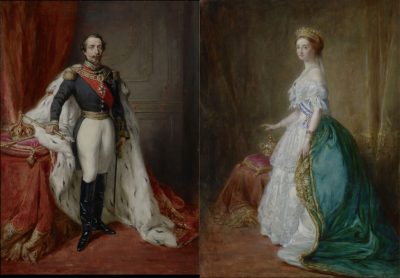
-
![[Hippolyte Prosper Olivier LISSAGARAY]. History of the Commune of 1871 / Translated from the French of Lissagaray by Eleanor Marx Aveling. London: Reeved and Turner, 1886. pp.: [i-v] vi-xv [1] 2-500.](https://varshavskycollection.com/wp-content/uploads/2021/02/LIB-1110.2016-d-500x500.jpeg) Hardcover volume, collated in-8o, 21.9 c 14.6 cm, bound in half red morocco over red buckram by Palmer, Hove & Co. (Manchester), ruled in gilt, marbled end-papers, top edge gilt, spine with raised bands, ruled in gilt, gilt lettering; bookplate "Ex libris William John Robertson" with black ink ms dated 1922 to front pastedown. Insert paper clipping “In Memoriam” marked “D.W. 25.1.61.” Graphite ms to t.p.: “[assisted by Karl Marx]”. Pp.: [i-v] vi-xv [xvi blank], [1] 2-500; collation: ffl blank first and last, π8 A-2H8 2I2. Title-page: HISTORY | OF | THE COMMUNE OF 1871. | Translated from the French of | LISSAGARAY, | BY | ELEANOR MARX AVELING. | LONDON: | REEVES AND TURNER, 196 STRAND. | 1886.|| Contributors: Hippolyte Prosper-Olivier Lissagaray (French, 1838 – 1901) – author. Eleanor Marx [Aveling] (British, 1855 – 1898) – translator. William John Robertson (Canadian, 1846 – 1894) – provenance. The Russian translation of the same title: [LIB-1158.2016] Э. Лиссагарэ. История Парижской Коммуны в 1871 г. (Дешевая библиотека, № 274) / Пер. под ред. В. Базарова. — С.-Петербург: Знание, 1906.
Hardcover volume, collated in-8o, 21.9 c 14.6 cm, bound in half red morocco over red buckram by Palmer, Hove & Co. (Manchester), ruled in gilt, marbled end-papers, top edge gilt, spine with raised bands, ruled in gilt, gilt lettering; bookplate "Ex libris William John Robertson" with black ink ms dated 1922 to front pastedown. Insert paper clipping “In Memoriam” marked “D.W. 25.1.61.” Graphite ms to t.p.: “[assisted by Karl Marx]”. Pp.: [i-v] vi-xv [xvi blank], [1] 2-500; collation: ffl blank first and last, π8 A-2H8 2I2. Title-page: HISTORY | OF | THE COMMUNE OF 1871. | Translated from the French of | LISSAGARAY, | BY | ELEANOR MARX AVELING. | LONDON: | REEVES AND TURNER, 196 STRAND. | 1886.|| Contributors: Hippolyte Prosper-Olivier Lissagaray (French, 1838 – 1901) – author. Eleanor Marx [Aveling] (British, 1855 – 1898) – translator. William John Robertson (Canadian, 1846 – 1894) – provenance. The Russian translation of the same title: [LIB-1158.2016] Э. Лиссагарэ. История Парижской Коммуны в 1871 г. (Дешевая библиотека, № 274) / Пер. под ред. В. Базарова. — С.-Петербург: Знание, 1906. -
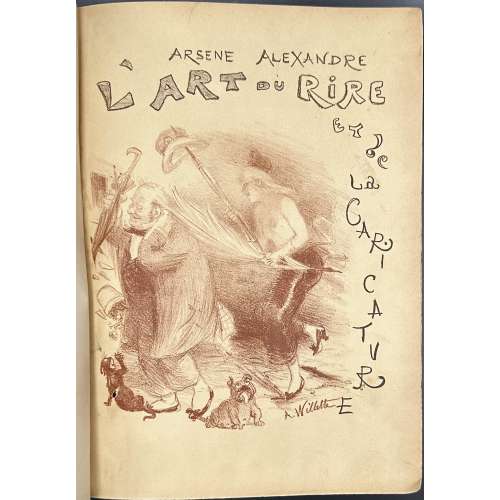 Hardcover volume 28.5 x 20.8 cm, quarter brown morocco over marbled boards, ruled in gilt, spine with raised bands, gilt in compartments, gilt lettering, marbled endpapers, top margin gilt, original lithographic wrappers designed by A. Willette preserved; pp.: [4] h.t., t.p., [1] 2-350 [2], 300 b/w ils in-text and 12 coloured photomechanical reproductions extraneous to collation; collated in-4o: π2 1-444; Title-page: L'ART DU RIRE | ET DE | LA CARICATURE | PAR ARSÈNE ALEXANDRE | 300 FAC-SIMILÉS EN NOIR ET 12 PLANCHES EN COULEURS | D’APRÈS LES ORIGINAUX | {vignette} | PARIS | ANCIENNE MAISON QUANIN | LIBRAIRIES-IMPRIMERIES RÉUNIES | 7, RUE ST-BENOIT | MAY & MOTTEROZ, DIRECTEURS || Contributors : Librairie-Imprimerie réunies (Paris, 1880-1908) – publisher. Arsène Alexandre (French, 1859 – 1937) – author. Adolphe Willette (French, 1857 – 1926) – artist (wrapper)
Hardcover volume 28.5 x 20.8 cm, quarter brown morocco over marbled boards, ruled in gilt, spine with raised bands, gilt in compartments, gilt lettering, marbled endpapers, top margin gilt, original lithographic wrappers designed by A. Willette preserved; pp.: [4] h.t., t.p., [1] 2-350 [2], 300 b/w ils in-text and 12 coloured photomechanical reproductions extraneous to collation; collated in-4o: π2 1-444; Title-page: L'ART DU RIRE | ET DE | LA CARICATURE | PAR ARSÈNE ALEXANDRE | 300 FAC-SIMILÉS EN NOIR ET 12 PLANCHES EN COULEURS | D’APRÈS LES ORIGINAUX | {vignette} | PARIS | ANCIENNE MAISON QUANIN | LIBRAIRIES-IMPRIMERIES RÉUNIES | 7, RUE ST-BENOIT | MAY & MOTTEROZ, DIRECTEURS || Contributors : Librairie-Imprimerie réunies (Paris, 1880-1908) – publisher. Arsène Alexandre (French, 1859 – 1937) – author. Adolphe Willette (French, 1857 – 1926) – artist (wrapper) -
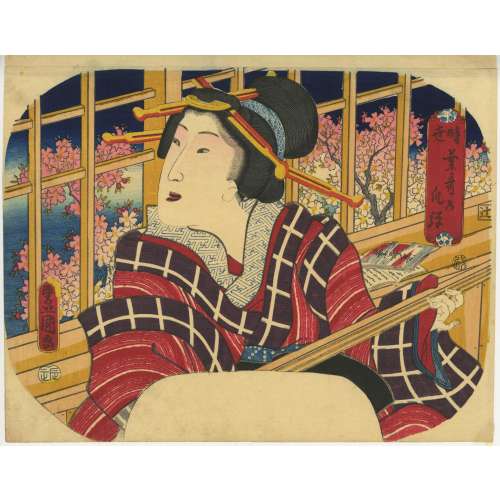 Artist: Utagawa Kunisada [歌川 国貞], a.k.a. Utagawa Toyokuni III [三代 歌川 豊国] (Japanese, 1786 – 1865). Signed: Toyokuni ga [豊国 画] in a red toshidama cartouche Publisher: Iseya Ichiemon [伊勢屋市右衛門] (Japanese, fl. c. 1820s – c. 1860s); seal Tsuji [辻] (Marks 16-029). Media: Untrimmed fan print (uchiwa-e), 225 x 295 mm, plus 10 mm paper strip glued on top (235 mm total height). Title: Plucking Popular Songs in Those Days [時世葉歌の爪弾] (Imayo ha-uta no tsuma-biki). Date seal and aratame seal: Ansei 3 (1856). Seller's Description: Uchiwa-e; picture intended for a summer fan. Here we see a relaxed beauty wearing loose layers of kimono and playing her shamisen instrument. She appears to be in the happy mood of spring, her singing inspired by the cherry blossoms in full bloom that we see outside of her window. She enjoys leisurely plucking with the plectrum of the shamisen and singing “ha-uta” (popular) songs. The title Ha-uta [葉歌] is normally written 端歌, which indicates a certain category of popular songs accompanied by shamisen with short texts that are drawn from daily life. Here however, the title葉歌 uses phonetically the same “ha葉“, referring to the title of the book of a collection of ha-uta songs, Matsu no ha [松の], which was published in five volumes in 1703 by Shûshôken 秀松軒. It is said that this collection of songs was written and sung by the blind (who were often musicians by livelihood). Behind her, lying on the window sill, we see two ha-uta songbooks, one open and one closed. The last half of the title tsuma-biki [爪弾] translates “to pluck with fingers” instead of a plectrum, which is the usual way of playing the shamisen.
Artist: Utagawa Kunisada [歌川 国貞], a.k.a. Utagawa Toyokuni III [三代 歌川 豊国] (Japanese, 1786 – 1865). Signed: Toyokuni ga [豊国 画] in a red toshidama cartouche Publisher: Iseya Ichiemon [伊勢屋市右衛門] (Japanese, fl. c. 1820s – c. 1860s); seal Tsuji [辻] (Marks 16-029). Media: Untrimmed fan print (uchiwa-e), 225 x 295 mm, plus 10 mm paper strip glued on top (235 mm total height). Title: Plucking Popular Songs in Those Days [時世葉歌の爪弾] (Imayo ha-uta no tsuma-biki). Date seal and aratame seal: Ansei 3 (1856). Seller's Description: Uchiwa-e; picture intended for a summer fan. Here we see a relaxed beauty wearing loose layers of kimono and playing her shamisen instrument. She appears to be in the happy mood of spring, her singing inspired by the cherry blossoms in full bloom that we see outside of her window. She enjoys leisurely plucking with the plectrum of the shamisen and singing “ha-uta” (popular) songs. The title Ha-uta [葉歌] is normally written 端歌, which indicates a certain category of popular songs accompanied by shamisen with short texts that are drawn from daily life. Here however, the title葉歌 uses phonetically the same “ha葉“, referring to the title of the book of a collection of ha-uta songs, Matsu no ha [松の], which was published in five volumes in 1703 by Shûshôken 秀松軒. It is said that this collection of songs was written and sung by the blind (who were often musicians by livelihood). Behind her, lying on the window sill, we see two ha-uta songbooks, one open and one closed. The last half of the title tsuma-biki [爪弾] translates “to pluck with fingers” instead of a plectrum, which is the usual way of playing the shamisen. -
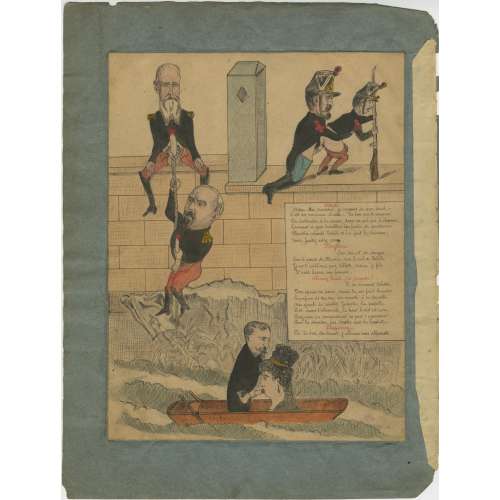 A series of seven political caricatures with indecent content, ink and pigment on paper, bound in a grey-blue folder. Each drawing is pasted to a grey-blue sheet of paper 32 x 24 cm. PLATES: 1) Villette; Bazaine; Alvarez Rull: 250 x 192 mm
A series of seven political caricatures with indecent content, ink and pigment on paper, bound in a grey-blue folder. Each drawing is pasted to a grey-blue sheet of paper 32 x 24 cm. PLATES: 1) Villette; Bazaine; Alvarez Rull: 250 x 192 mm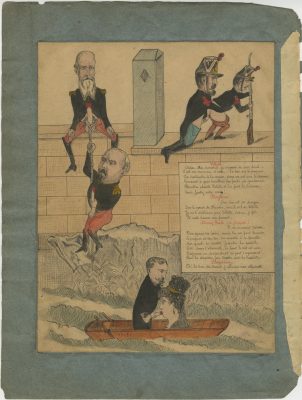
Villette Adieu, cher maréchal, je réponds de mon dard C’est un morceau d’acier… Là bas, sur le rempart, Sa cartouche à la main, dans un cul qui le charme, Lançant à gros bouillons son foutre de gendarme Plantin plante Delille et lui font le Caisson. Bazaine Sur ton vit de dragon Sur le nœud de Plantin, sur le cul de Delille, Je ne t’oublierai pas, Villette, adieu, je file Et je vais baiser ma femme. Alvarez Rull (à Josépha) Il ne saurait tarder, Ton epoux va venir, mais tu me fais bander, Le parfum de ton con me monte à la cervelle, Ma gaule se raidit . Josépha, la nacelle Est dans l’ obscurité, là haut, le ciel est noir, Bazaine en descendant ne peut t’ apercevoir … Pour la dernière fois, torche moi la houlette. Bazaine Eh ! là bas, du canot, j’allume une allumette!
Villette Farewell, dear Marshal, I vouch for my dick. It’s like a steel rod … Over there, on the ramparts, Plantin, his dick in hand, pounds Delisle’s beckoning ass And fills it with his bubbling gendarme’s cum. Bazaine For your dragoon’s dick, For Plantin's prick, for Delisle's ass, I won't forget you, Villette, goodbye, I'm leaving And I'm going to fuck my wife. Alvarez Rull (to Josépha) Hurry up, Your husband is coming, but I got a hard on you, The scent of your cunt penetrates my brain, My rod stiffened. Josépha, the gondola Is in the dark, the sky is black, Bazaine coming down and cannot see you... Give me one last blowjob.Bazaine Hey! Over there, from the canoe, I light a match!
French marshal Achille Bazaine capitulated to Bismarck during the Franco-Prussian war on 27 October 1870. In 1873, he was tried for treason and received a death sentence, later commuted to 20 years' imprisonment. Bazaine was incarcerated in the Fort Royal on Île Sainte-Marguerite, from which he escaped on August 9–10, 1874, with the help of Colonel Villette [Willette], his wife Josefa [Pepita Peña], and her nephew Alvarez Rull. They sailed to Genoa in Italy and from there to London. Plantin and Delisle were prison guards. The story was described in detail during the Trial of Col. Villette and his Accomplices in 1874 and published later in Robert Christophe. La Vie tragique du maréchal Bazaine. — Paris: Vautrain Jacques, 1947.
2) Impératrice Eugénie: 218 x 165 mm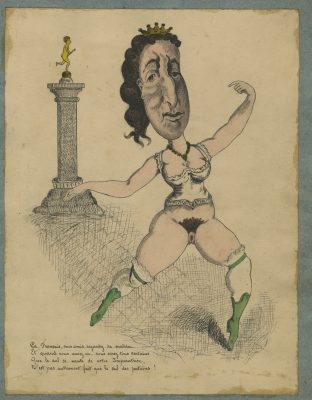
Ça, Français, mes amis, regardez sa matrice, Et quand vous aurez vu, vous serez tous certains Que le cul si vanté de votre Impératrice, N’est pas autrement fait que le cul des putains!
That, French, my friends, look at her cunt, And when you have seen, you will all be certain That the so acclaimed ass of your Empress, Is no different than the ass of whores! 3) Napoléon III: 215 x 168 mm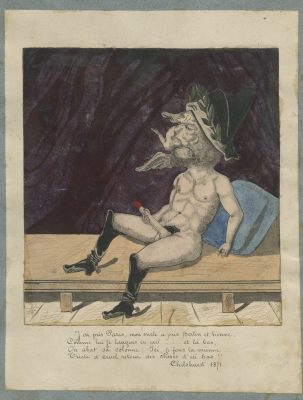
J’ai pris Paris, mon oncle a pris Berlin et Vienne. Comme lui je languis en exil …… et là bas, On abat sa colonne; Ici, je fous la mienne…. Triste et cruel retour des choses d’ici bas!! Chilshurst 1871. [i.e. Chislehurst]
I took Paris, my uncle took Berlin and Vienna. Like him, I, too, languish in exile. His column there was demolished; I’m jerking mine off here…. Cruel and sorrowful deeds!! 4) La confession: 216 x 168 mm (Georges Darboy?)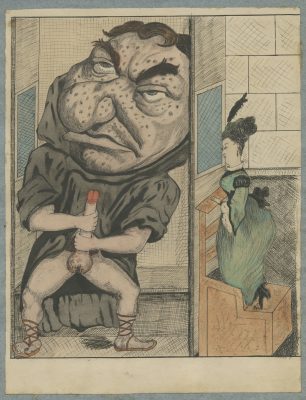 5) Napoléon III et Thérèsa (chanteuse Désirée Emma Valladon): 216 x 176 mm
5) Napoléon III et Thérèsa (chanteuse Désirée Emma Valladon): 216 x 176 mm
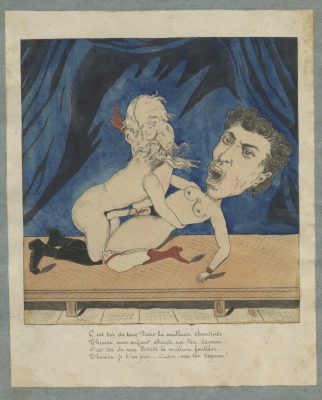
C’est toi de tout Paris la meilleure chanteuse, Thérèsa mon enfant, chante-moi ton sapeur. C’est toi de mes Etats la meilleure fonteuse.. Thérèsa je t’en prie … Ouvre-moi ton sapeur!
You, the best singer in all of Paris, Teresa, my child, sing for me where to insert. You are the best padding in my entire country… Teresa, please... Open your slit for me! 6) Thiers: 219 x 168 mm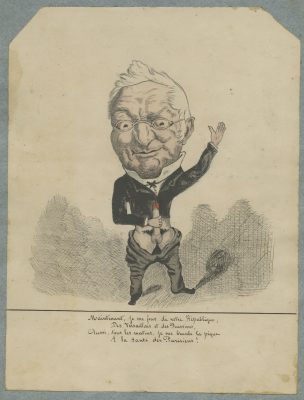
Maintenant, je me fous de votre République, Des Versaillais et des Prussiens, Aussi, tous les matins, je me branle la pique A la santé des Parisiens!
Yes, I don’t care about your Republic now, About Versailles and the Prussians, And every morning I jerk off For the health of Parisians! 7) Émile Ollivier/Rochefort/Jules Favre/Gambetta : 212 x 168 mm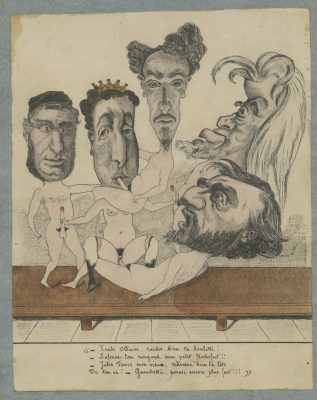
« — Emile Ollivier, raidis bien la houlette! — Enfonce ton ringard mon petit Rochefort!! — Jules Favre mon vieux, redresse bien la tête De ton vi! — Gambetta, pousse encore plus fort!!! »
Emile Ollivier, tighten your dick! - Stick in your poker, my little Rochefort!! - Jules Favre, old man, straighten your dickhead Damn it! – Gambetta, push even harder!!!Characters: Bazaine, François Achille (French, 1811 – 1888) Darboy, Georges (French, 1813 – 1871) Favre, Jules (French, 1809 – 1880) Gambetta, Léon (French, 1838 – 1882) Montijo, Eugénie de (Spanish-French, 1826 – 1920) Napoleon III [Bonaparte, Charles-Louis Napoléon] (French, 1808 – 1873) Ollivier, Émile (French, 1825 – 1913) Peña Azcárate, Josefa [Peña, Pepita] (Mexican-French, 1847 – 1900); Alvarez Rull – nephew of Josefa Peña Azcárate. Rochefort, Henri (French, 1831 – 1913) Thérésa [Valladon, Désirée Emma] (French, 1836 – 1913) Thiers, Adolphe (French, 1797 – 1877)
-
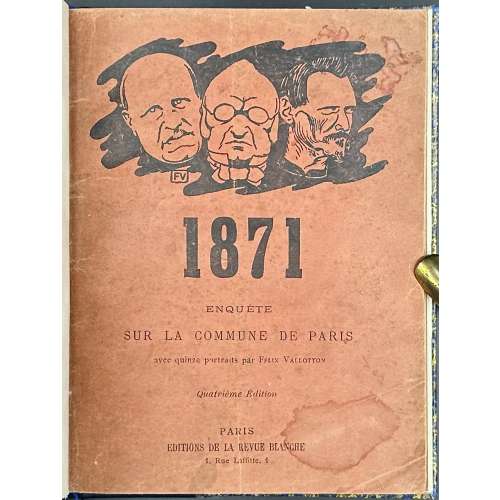 Hardcover, 20.2 x 15.5 cm, owner’s half blue morocco binding over marbled boards with gilt lettering to spine, marbled endpapers, extracts from La Revue Blanche, numbers 91 and 92 of March 15 and April 1 of 1897 (année VII, tome XII), publisher’s pink wrappers preserved, pp. [2] [1-5] 6-160. Ref.: Bridget Alsdorf. Vallotton, Fénéon, and the Legacy of the Commune in Fin-de-siècle France. Portraits: François [Quico] Merlin Colonel Merlin (French, 1814 – 1900) Adolphe Thiers (French, 1797 – 1877) Commandant Gaveau Fortuné Henry (French, 1821 – 1882) Otto von Bismarck (German, 1815 – 1898) Henri, comte de Chambord (French, 1820 – 1883) Louis Rossel (French, 1844 – 1871) François Huet Tranquille (French, 1842 – after 1879) Joseph Vinoy (French, 1803 – 1880) Raoul Rigault (French, 1846 – 1871) Eugène Varlin (French, 1839 – 1871) Théophile Ferré (French, 1845 – 1871) Georges Darboy (French, 1813 – 1871) Auguste Vermorel (French, 1841 – 1871) Jaroslaw Dombrowski [Jarosław Dąbrowski] (Polish-French, 1836 – 1871) Contributors: Félix Fénéon (French, 1861 – 1944) Félix Vallotton (French, 1865 – 1925) La Revue Blanche (Paris) Imprimerie Alcan-Lévy
Hardcover, 20.2 x 15.5 cm, owner’s half blue morocco binding over marbled boards with gilt lettering to spine, marbled endpapers, extracts from La Revue Blanche, numbers 91 and 92 of March 15 and April 1 of 1897 (année VII, tome XII), publisher’s pink wrappers preserved, pp. [2] [1-5] 6-160. Ref.: Bridget Alsdorf. Vallotton, Fénéon, and the Legacy of the Commune in Fin-de-siècle France. Portraits: François [Quico] Merlin Colonel Merlin (French, 1814 – 1900) Adolphe Thiers (French, 1797 – 1877) Commandant Gaveau Fortuné Henry (French, 1821 – 1882) Otto von Bismarck (German, 1815 – 1898) Henri, comte de Chambord (French, 1820 – 1883) Louis Rossel (French, 1844 – 1871) François Huet Tranquille (French, 1842 – after 1879) Joseph Vinoy (French, 1803 – 1880) Raoul Rigault (French, 1846 – 1871) Eugène Varlin (French, 1839 – 1871) Théophile Ferré (French, 1845 – 1871) Georges Darboy (French, 1813 – 1871) Auguste Vermorel (French, 1841 – 1871) Jaroslaw Dombrowski [Jarosław Dąbrowski] (Polish-French, 1836 – 1871) Contributors: Félix Fénéon (French, 1861 – 1944) Félix Vallotton (French, 1865 – 1925) La Revue Blanche (Paris) Imprimerie Alcan-Lévy -
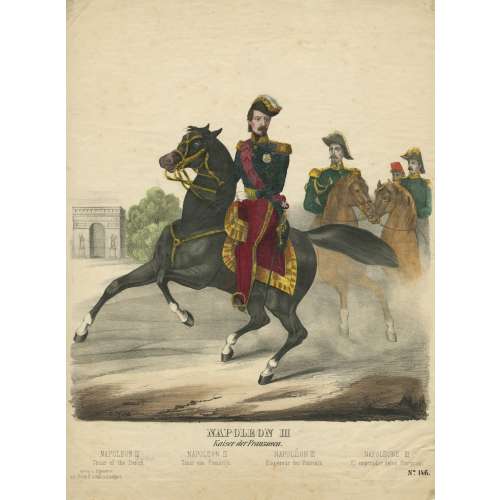 Hand-coloured lithography on wove paper 423 x 332 mm; On reverse: black ink stamp “4956”, ms “A”, ms pencil “428” and “Ernest”. Under the image, centre: "NAPOLEON III | Kaiser der Franzosen." Velow: | NAPOLEON III | Czaar of the French — NAPOLEON III | Czaar van Frankrijk — NAPOLÉON III | Empereur des Francais. — NAPOLEONE III | El emperador delos Franceses; bottom left: "Verlag u. Eigenthum | von. Fried. G. Schulz in Stuttgart.", right: "No 146." The artist's and printer's names in stone are not legible. Published in Stuttgart by Friederich Gustav Schulz (German, 1786 – 1859) during the time of the Second French Empire (1852-1870).
Hand-coloured lithography on wove paper 423 x 332 mm; On reverse: black ink stamp “4956”, ms “A”, ms pencil “428” and “Ernest”. Under the image, centre: "NAPOLEON III | Kaiser der Franzosen." Velow: | NAPOLEON III | Czaar of the French — NAPOLEON III | Czaar van Frankrijk — NAPOLÉON III | Empereur des Francais. — NAPOLEONE III | El emperador delos Franceses; bottom left: "Verlag u. Eigenthum | von. Fried. G. Schulz in Stuttgart.", right: "No 146." The artist's and printer's names in stone are not legible. Published in Stuttgart by Friederich Gustav Schulz (German, 1786 – 1859) during the time of the Second French Empire (1852-1870). -
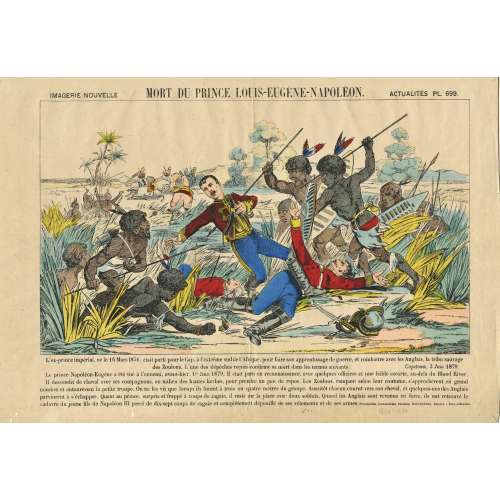 Hand-coloured lithography on wove paper, 275 x 385 mm; vertical centerfold, image in frame. On reverse: black ink stamp “5350”. Above the frame: "IMAGERIE NOUVELLE — MORT DU PRINCE LOUIS-EUGÈNE-NAPOLÉON. — ACTUALITÉS PL. 699". Under the frame: "L'ex-prince impérial, né le 16 Mars I856, était parti pour le Cap, à l'extrême sud de l'Afrique, pour faire son apprentissage de guerre, et combattre avec les Anglais, la tribu sauvage des Zoulous. L'une des dépêches reçues confirme sa mort dans les termes suivants: — Capetown, 3 Juin 1879. — Le prince Napoléon-Eugène a été tué à l'ennemi, avant-hier, 1er Juin 1879, Il était parti en reconnaissance, avec quelques officiers et une fable escorte, au-delà du Blood River. Il descendit de cheval ave ses compagnons, au milieu des hautes herbes, pour prendre un peu de repos. Les Zoulous, rampant selon leur coutume, s'approchèrent en grand nombre et entourèrent la petite troupe. On ne les vit que lorsqu' ils furent à trois ou quatre mètres du groupe. Aussitôt chacun court vers son cheval, et quelques-uns des Anglais parvinrent à s'échapper. Quant au prince, surpris et frappé à coups de zagaie, il resta sur la place avec deux soldats. Quand les Anglais sont revenus en force, ils ont retrouvé le cadavre du jeune fils de Napoléon III percé de dix-sept coups de zagaie et complétement dépouillé de ses vêtements et de ses armes". — "Typographie, Lithographie, Imagerie, Haguenthal, Éditeur à Pont-à-Mousson". Pencil ms: "1860-1880". Élie Haguenthal (French, 1822 – 1881) – publisher/printer.
Hand-coloured lithography on wove paper, 275 x 385 mm; vertical centerfold, image in frame. On reverse: black ink stamp “5350”. Above the frame: "IMAGERIE NOUVELLE — MORT DU PRINCE LOUIS-EUGÈNE-NAPOLÉON. — ACTUALITÉS PL. 699". Under the frame: "L'ex-prince impérial, né le 16 Mars I856, était parti pour le Cap, à l'extrême sud de l'Afrique, pour faire son apprentissage de guerre, et combattre avec les Anglais, la tribu sauvage des Zoulous. L'une des dépêches reçues confirme sa mort dans les termes suivants: — Capetown, 3 Juin 1879. — Le prince Napoléon-Eugène a été tué à l'ennemi, avant-hier, 1er Juin 1879, Il était parti en reconnaissance, avec quelques officiers et une fable escorte, au-delà du Blood River. Il descendit de cheval ave ses compagnons, au milieu des hautes herbes, pour prendre un peu de repos. Les Zoulous, rampant selon leur coutume, s'approchèrent en grand nombre et entourèrent la petite troupe. On ne les vit que lorsqu' ils furent à trois ou quatre mètres du groupe. Aussitôt chacun court vers son cheval, et quelques-uns des Anglais parvinrent à s'échapper. Quant au prince, surpris et frappé à coups de zagaie, il resta sur la place avec deux soldats. Quand les Anglais sont revenus en force, ils ont retrouvé le cadavre du jeune fils de Napoléon III percé de dix-sept coups de zagaie et complétement dépouillé de ses vêtements et de ses armes". — "Typographie, Lithographie, Imagerie, Haguenthal, Éditeur à Pont-à-Mousson". Pencil ms: "1860-1880". Élie Haguenthal (French, 1822 – 1881) – publisher/printer. -
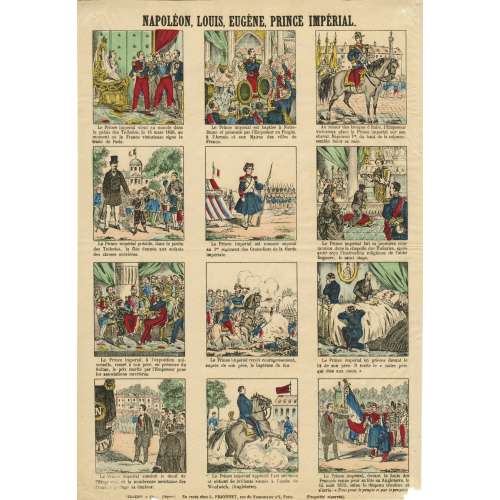 Hand-coloured woodcut on wove paper, 400 x 277 mm. Top: "NAPOLÉON, LOUIS, EUGÈNE, PRINCE IMPÉRIAL"; bellow 12 captioned frames:
Hand-coloured woodcut on wove paper, 400 x 277 mm. Top: "NAPOLÉON, LOUIS, EUGÈNE, PRINCE IMPÉRIAL"; bellow 12 captioned frames:- Le Prince impérial vient au monde dans le palais des Tuileries, le 16 mars 1856, au moment où la France victorieuse signe le traité de Paris.
- Le Prince impérial est baptisé à Notre-Dame et présenté par l'Empereur au Peuple, à l’Armée et aux Maires des villes de France.
- Au retour des troupes d'Italie, l'Empereur victorieux place le Prince impérial sur son cheval. Napoléon Ier, du haut de la colonne, semble bénir sa race.
- Le Prince impérial préside, dans le jardin des Tuileries, la fête donnée aux enfants des classes ouvrières.
- Le Prince impérial est nommé caporal au 1er régiment des Grenadiers de la Garde impériale.
- Le Prince impérial fait sa première communion dans la chapelle des Tuileries, après avoir reçu l'instruction religieuse de l'abbé Deguerry, le saint otage.
- Le Prince impérial, à l'exposition universelle, remet à son père. en présence du Sultan, le prix mérité par l'Empereur pour les associations ouvrières.
- Le Prince impérial reçoit courageusement, auprès de son père, le baptême du feu.
- Le Prince impérial en prières devant le lit de son père. Il récite le « notre père qui ètes aux cieux. »
- Le Prince impérial conduit le deuil de l'Empereur, et la nombreuse assistance des Français portage sa douleur.
- Le Prince impérial apprend l’art militaire et obtient de brillants succès à l'écolo de Woolwich, (Angleterre).
- Le Prince impérial, devant la foule des Français venus pour sa fête en Angleterre, le 15 out 1873, salue le drapeau tricolore et s'écrie : « Tout pour le peuple et par le peuple… »
-
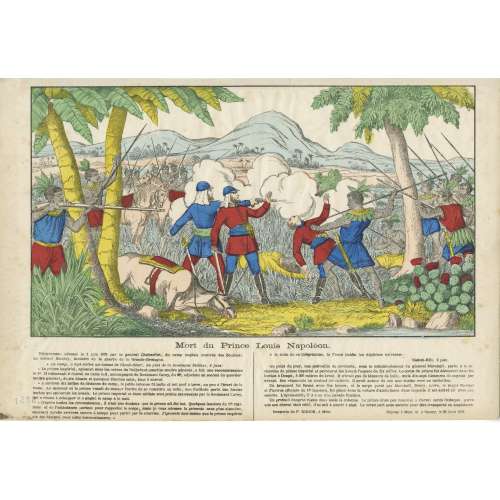 Hand-coloured woodcut on wove paper, 267 x 390 mm. On reverse: black ink stamp “5351”. Centre, under the image frame "Mort du Prince Louis Napoléon". Below left: "Télégramme adressé le 2 juin 1879 par le général Chelmsfort, du camp anglais (contrée des Zoulous), au colonel Stanley, ministre de la guerre de la Grande-Bretagne. « Au camp, à sept milles au-dessus de Blood-River, au pied de la montagne Stellezi, 2 juin: Le prince impérial, agissant sous les ordres de l'adjudant quartier-maitre général. a fait une reconnaissance le 1er. Il retournait à cheval au camp le 2 accompagné du lieutenant Carey, du 98e adjudant en second du quartier-maitre général. de six blancs et, quelques Zoulous amis, tous à cheval. A environ dix milles de distance du camp, la petite colonne fit halte at mit pied à terre, un peu à l’écart de la route. Au moment ou le prince venait de donner l'ordre de se remettre en selle. une fusillade partit des hautes herbes qui entourant les kraals. Le prince impérial et deux soldats sont portés manquants par le lieutenant Carey, qui a réussi à échapper et a gagné le camp à la nuit. D'après toutes les circonstances, il 'est pas douteux quo le prince ait été tué. Quelques lanciers du 17 régiment et de l'ambulance partent pour rapporter le corps; mais je vous adresse la présente sans plus attendre, espérant qu'elle arrivera encore à temps pour partir par le courrier. J’ignorais moi-même que le prince impérial eût été désigné pour cette reconnaissance. »" Below right: A la suite de le télégramme, le Times publie les dépêches suivantes: Stelezi-Hill, 2 juin. Au point du jour, une patrouille de cavalerie, sous le commandement du général Marshall. partit à la recherche du prince impérial et parcourut les kraals l'espace de dix milles. Le corps du prince fut découvert dans les herbes à Donga, à 300 mètres du kraal. Il n'avait pas de blessure de balle, mais dix-sept blessures de zagaies par devant. Ses vêtements lui avaient été enlevés. I avait autour du cou une chaine avec un médaillon. Un brancard fut formé avec les lances, et le corps porté par Marchall, Drury, Lowe, le mjor Stewart et d'autres officiers du 17e lanciers, fut. place dans la voiture d'ambulance dans laquelle il est arrivé ici avec une escorte. L'après-midi, il v a eu une parade funèbre. Un profond chagrin règne dans toute la colonne. Le prince n'est pas remonté à cheval après l’attique, parce que son cheval était rétif ; il se mit à courir à pied. Le corps part sous escorte pour être transporté en Angleterre. Bottom right: "Imagerie de P. DIDION, à Metz — Déposé à Metz et à Nancy, le 25 Juin 1879". Paulin Didion (French, 1831 – 1879) – publisher/printer.
Hand-coloured woodcut on wove paper, 267 x 390 mm. On reverse: black ink stamp “5351”. Centre, under the image frame "Mort du Prince Louis Napoléon". Below left: "Télégramme adressé le 2 juin 1879 par le général Chelmsfort, du camp anglais (contrée des Zoulous), au colonel Stanley, ministre de la guerre de la Grande-Bretagne. « Au camp, à sept milles au-dessus de Blood-River, au pied de la montagne Stellezi, 2 juin: Le prince impérial, agissant sous les ordres de l'adjudant quartier-maitre général. a fait une reconnaissance le 1er. Il retournait à cheval au camp le 2 accompagné du lieutenant Carey, du 98e adjudant en second du quartier-maitre général. de six blancs et, quelques Zoulous amis, tous à cheval. A environ dix milles de distance du camp, la petite colonne fit halte at mit pied à terre, un peu à l’écart de la route. Au moment ou le prince venait de donner l'ordre de se remettre en selle. une fusillade partit des hautes herbes qui entourant les kraals. Le prince impérial et deux soldats sont portés manquants par le lieutenant Carey, qui a réussi à échapper et a gagné le camp à la nuit. D'après toutes les circonstances, il 'est pas douteux quo le prince ait été tué. Quelques lanciers du 17 régiment et de l'ambulance partent pour rapporter le corps; mais je vous adresse la présente sans plus attendre, espérant qu'elle arrivera encore à temps pour partir par le courrier. J’ignorais moi-même que le prince impérial eût été désigné pour cette reconnaissance. »" Below right: A la suite de le télégramme, le Times publie les dépêches suivantes: Stelezi-Hill, 2 juin. Au point du jour, une patrouille de cavalerie, sous le commandement du général Marshall. partit à la recherche du prince impérial et parcourut les kraals l'espace de dix milles. Le corps du prince fut découvert dans les herbes à Donga, à 300 mètres du kraal. Il n'avait pas de blessure de balle, mais dix-sept blessures de zagaies par devant. Ses vêtements lui avaient été enlevés. I avait autour du cou une chaine avec un médaillon. Un brancard fut formé avec les lances, et le corps porté par Marchall, Drury, Lowe, le mjor Stewart et d'autres officiers du 17e lanciers, fut. place dans la voiture d'ambulance dans laquelle il est arrivé ici avec une escorte. L'après-midi, il v a eu une parade funèbre. Un profond chagrin règne dans toute la colonne. Le prince n'est pas remonté à cheval après l’attique, parce que son cheval était rétif ; il se mit à courir à pied. Le corps part sous escorte pour être transporté en Angleterre. Bottom right: "Imagerie de P. DIDION, à Metz — Déposé à Metz et à Nancy, le 25 Juin 1879". Paulin Didion (French, 1831 – 1879) – publisher/printer. -
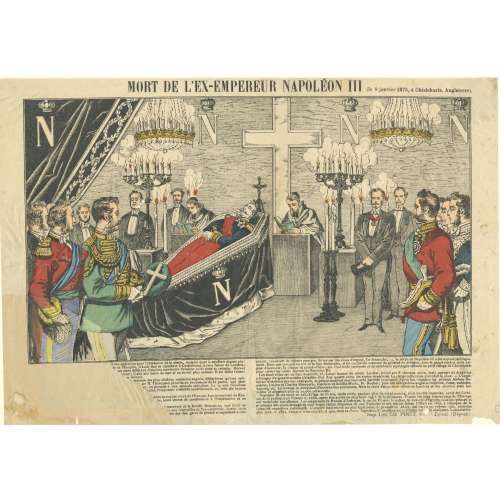 Hand-coloured woodcut on wove paper, 270 x 380 mm; attached to the sheet 303 x 442 mm with pencil ms inscription to the top left corner on the reverse: “Haye le 2-3-75”. Top: "MORT DE L'EX-EMPEREUR NAPOLÉON III (le 9 janvier 1873, à Chislehurts [sic], Angleterre)." Bottom right: "Imp. Lith. CH. PINOT, éditeur. Épinal (Dépose)". Bottom left corner of the image sheet torn and manually restored. Text partially lost, starting with « d’une opération pour l’extraction de la pierre, maladie dont’ il souffrait depuis plu-… ». See Chislehurst. Charles-François Pinot (French, 1817 – 1879) – publisher/printer.
Hand-coloured woodcut on wove paper, 270 x 380 mm; attached to the sheet 303 x 442 mm with pencil ms inscription to the top left corner on the reverse: “Haye le 2-3-75”. Top: "MORT DE L'EX-EMPEREUR NAPOLÉON III (le 9 janvier 1873, à Chislehurts [sic], Angleterre)." Bottom right: "Imp. Lith. CH. PINOT, éditeur. Épinal (Dépose)". Bottom left corner of the image sheet torn and manually restored. Text partially lost, starting with « d’une opération pour l’extraction de la pierre, maladie dont’ il souffrait depuis plu-… ». See Chislehurst. Charles-François Pinot (French, 1817 – 1879) – publisher/printer. -
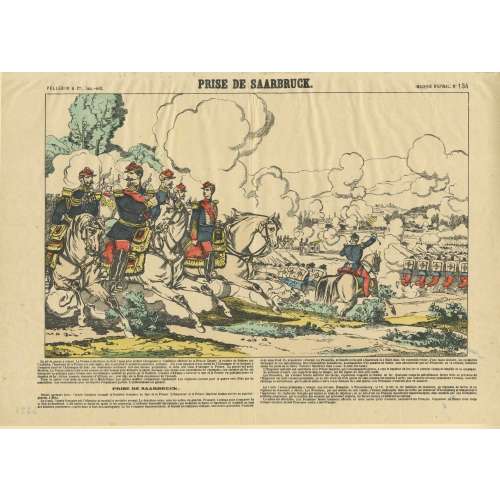 Hand-coloured woodcut on wove paper, 268 x 381 mm, vertical centerfold. On reverse: black ink stamp “5324”. Top centre: "PRISE DE SAARBRUCK"; left: "PELLERIN & Cie, imp. -édit."; right: "IMAGERIE D'EPINAL, № 134." Under the frame text starts with « La cri de guerre a retenti. La France a été forcée de tirer l’épée pour arrêter… ».[...] Prise de Saarbruck. | Depuis quelques jours, l’armée française occupait la frontière française en face de la Prusse.... Jean Charles Pellerin (French, 1756 – 1836) – publisher/printer. The Battle of Saarbrücken (2 August 1870).
Hand-coloured woodcut on wove paper, 268 x 381 mm, vertical centerfold. On reverse: black ink stamp “5324”. Top centre: "PRISE DE SAARBRUCK"; left: "PELLERIN & Cie, imp. -édit."; right: "IMAGERIE D'EPINAL, № 134." Under the frame text starts with « La cri de guerre a retenti. La France a été forcée de tirer l’épée pour arrêter… ».[...] Prise de Saarbruck. | Depuis quelques jours, l’armée française occupait la frontière française en face de la Prusse.... Jean Charles Pellerin (French, 1756 – 1836) – publisher/printer. The Battle of Saarbrücken (2 August 1870). -
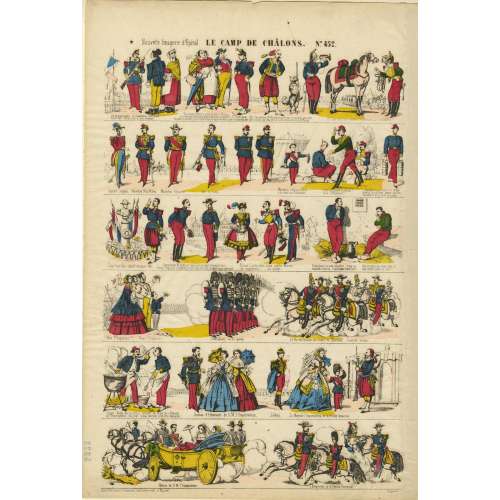 Hand-coloured woodcut on wove paper, 409 x 280 mm; black ink stamp “5323” to reverse; attached to the sheet 487 x 320 mm. Top centre: "LE CAMP DE CHALONS."; left: "Nouvelle Imagerre d'Epinal"; right: № 452. Bottom left: "Imp lith. Pinot & Sagaire, libraires edit. à Épinal"; right: "Déposé". Image: 6-tier cartoon with captions about Napoleon III and his son Prince Imperial (Napoléon Eugène Louis Jean Joseph Bonaparte; 16 March 1856 – 1 June 1879). Le camp de Chalons Pinot & Sagaire (Épinal, 1861 – 1888) – enterprise, publisher/printer. Charles-François Pinot (French, 1817 – 1879) – publisher/printer.
Hand-coloured woodcut on wove paper, 409 x 280 mm; black ink stamp “5323” to reverse; attached to the sheet 487 x 320 mm. Top centre: "LE CAMP DE CHALONS."; left: "Nouvelle Imagerre d'Epinal"; right: № 452. Bottom left: "Imp lith. Pinot & Sagaire, libraires edit. à Épinal"; right: "Déposé". Image: 6-tier cartoon with captions about Napoleon III and his son Prince Imperial (Napoléon Eugène Louis Jean Joseph Bonaparte; 16 March 1856 – 1 June 1879). Le camp de Chalons Pinot & Sagaire (Épinal, 1861 – 1888) – enterprise, publisher/printer. Charles-François Pinot (French, 1817 – 1879) – publisher/printer. -
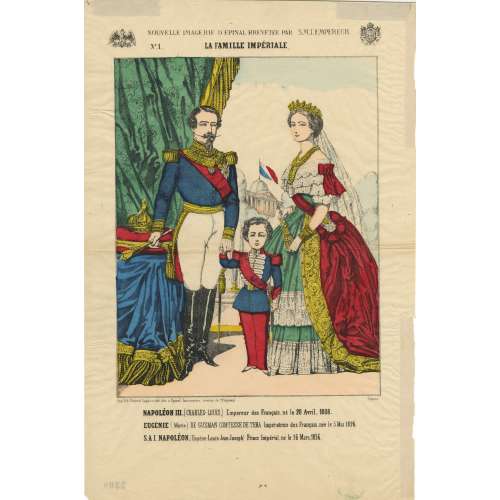 Hand-coloured woodcut on wove paper, 390 x 260 mm; black ink stamp “5308” to reverse; horizontal centerfold. Centre top: "NOUVELLE IMAGERIE D'ÉPINAL BREVETÉE PAR S.M.L’EMPEREUR" with imperial eagle and coat of arms at right and left. Below: "№ 1." — "LA FAMILLE IMPÉRIALE"; image in frame; under the image, left: "Imp lith. Pinot & Sagaire, édit. libr. à Épinal, fournisseurs brevetés de l’Empereur"; right: "Déposé". Bottom: "NAPOLÉON I. (CHARLES-LOUIS,) Empereur des Français, né le 20 Avril, 1808. | EUGÉNIE ( Marie) DE GUSMAN COMTESSE DE TEBA Impératrice des Français, née le 5 Mai 1826. | S.A I. NAPOLÉON. (Eugène-Louis-Jean-Joseph) Prince Impérial, ne le 16 Mars. 1856." Napoleon III [Charles-Louis Napoléon Bonaparte] (French, 1808 – 1873) Eugénie de Montijo [L'impératrice Eugénie] (Spanish-French, 1826 – 1920) Napoléon, Prince Imperial (Napoléon Eugène Louis Jean Joseph Bonaparte] (French, 1856 – 1879) Pinot & Sagaire (Épinal, 1861 – 1888) – enterprise, publisher/printer. Charles-François Pinot (French, 1817 – 1879) – publisher/printer.
Hand-coloured woodcut on wove paper, 390 x 260 mm; black ink stamp “5308” to reverse; horizontal centerfold. Centre top: "NOUVELLE IMAGERIE D'ÉPINAL BREVETÉE PAR S.M.L’EMPEREUR" with imperial eagle and coat of arms at right and left. Below: "№ 1." — "LA FAMILLE IMPÉRIALE"; image in frame; under the image, left: "Imp lith. Pinot & Sagaire, édit. libr. à Épinal, fournisseurs brevetés de l’Empereur"; right: "Déposé". Bottom: "NAPOLÉON I. (CHARLES-LOUIS,) Empereur des Français, né le 20 Avril, 1808. | EUGÉNIE ( Marie) DE GUSMAN COMTESSE DE TEBA Impératrice des Français, née le 5 Mai 1826. | S.A I. NAPOLÉON. (Eugène-Louis-Jean-Joseph) Prince Impérial, ne le 16 Mars. 1856." Napoleon III [Charles-Louis Napoléon Bonaparte] (French, 1808 – 1873) Eugénie de Montijo [L'impératrice Eugénie] (Spanish-French, 1826 – 1920) Napoléon, Prince Imperial (Napoléon Eugène Louis Jean Joseph Bonaparte] (French, 1856 – 1879) Pinot & Sagaire (Épinal, 1861 – 1888) – enterprise, publisher/printer. Charles-François Pinot (French, 1817 – 1879) – publisher/printer.


